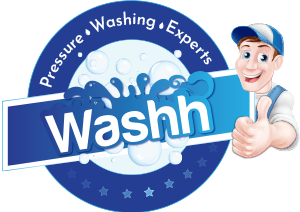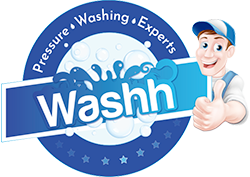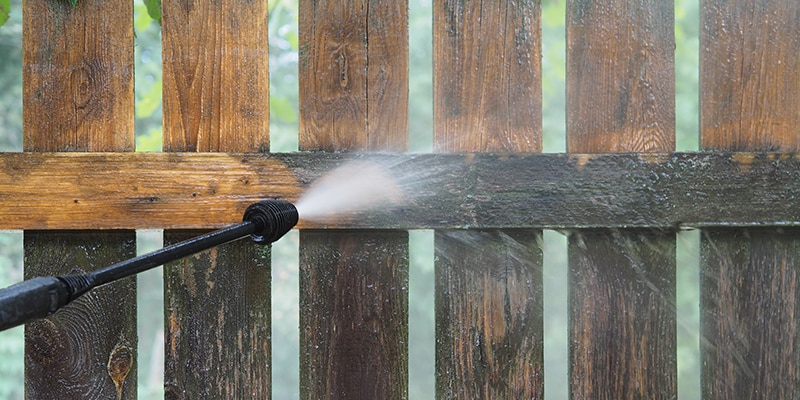Homeowners who pressure wash a fence will know it’s a good way to prepare them for staining or restore them to their original appearance. However, if you are new to the pressure-washing game, it is important to exercise caution. While effective for cleaning, a pressure washer can inflict great damage not only to the fence itself but also to you. Fortunately, you can adopt some tried-and-tested tips for safe and successful results.
Is It Okay to Pressure Wash a Fence?
Because pressure washers spew out water with great force, it is normal to worry about damage. After all, there are some things you can’t pressure wash. But is a fence one of them?
In general, it is perfectly fine to clean a fence using a pressure washer. The catch, though, is that you must do it the right way. This means using the right combination of force, nozzle, detergent, and technique. Using too low pressure will not effectively get rid of dirt and stains, while pressure that is too high or narrow can chip away the wood.
Preparation: What to Do Before Pressure Washing
You might be itching to jump into fence power washing. But, before you pressure wash fence structures on your property, it’s important to do a little prep work.
Safety First
Make sure to wear protective clothing and eye gear. Injuries are not uncommon in the world of pressure washing. A pressure washer can bruise and even cut through flesh when used incorrectly. There is also a risk of contracting an infection if the laceration is deep and exposed to bacteria.
You should also learn how to use a pressure washer properly. Never leave the pressure washer unattended or have it stand on uneven surfaces. Furthermore, it’s best to place it somewhere that won’t get in your way. You don’t want to trip while working with a pressure washer. It’s also a good idea to stand around two feet away from the pressure washer to avoid accidents.
After switching off the pressure washer, make sure to release any remaining pressure, too. You can do this by squeezing the wand trigger before disconnecting all nozzles and hoses.
Prepare the Area
Preparation is integral to safe and effective pressure washing. Before blasting away at your fence, make sure to clear the surrounding area and remove any loose debris. Lawn furniture and other objects should be set aside, far from the fence, as there is a risk of sending these things flying. Don’t miss out on any small objects, too, as you may trip over them and hurt yourself.
Even if your fence isn’t directly adjacent to your house, make sure to shut all doors, windows, and any other openings. This will prevent water from flooding your home. Cover any nearby fixtures, plants, and outlets with a tarp. Beyond that, see to it that you read the manufacturer’s instructions on your pressure washer before starting the project.
Finally, before diving in with a pressure washer, give your fence a thorough sweep or brush. This will help get rid of loose dirt, dust, and debris.
Protect Plants and Soil
In addition to covering nearby plants and soil with a tarp, you may also want to spray them with a hose. This will prevent detergent and any runoff from soaking into the soil and damaging your plants. If you have flower pots instead of an in-ground garden, move them away from the washing area.
How to Pressure Wash a Fence
Now that everything’s ready, it’s time to jump into pressure washing fence boards. Here’s how to pressure wash a fence properly.
1. Use the Right Nozzle and PSI
When done with the wrong nozzle, pressure washing a wooden fence can result in severe damage. A nozzle that’s too fine or narrow can carve through wood. The best nozzle to use for this project is a 25-degree tip, which is usually in the color green. This nozzle will effectively remove dirt and grime without damaging the wood.
Let’s move on to the PSI. What is the best PSI to clean a fence? It depends on the material. If you’re pressure washing a wooden fence, the right PSI will depend on the hardness of the wood. Generally, you should aim for a PSI between 500 to 800 for softer woods and between 1200 to 1500 for harder woods.
Of course, there are other variables at play. The condition of your wooden fence can also influence the right PSI level. As such, for damage-free wood fence cleaning, it is a good idea to test out the PSI in a small area of the fence first before applying the same pressure to the rest of the fence. On the other hand, a PSI of 2400 is generally safe for cleaning vinyl fences.
2. Choose a Proper Fence Cleaner
There are different detergents you can use to clean your fence, but you should opt for one that’s specifically designed for your fence’s material. There are detergents specifically made for wood, and these should be tough enough to get rid of moss and mold while safe enough to avoid damaging the fence. Don’t forget to let the detergent sit for 5 to 10 minutes before washing it off with water.
3. Clean With the Right Approach
The best way to pressure wash fence structures is to apply detergent using a bottom-up and left-to-right approach. This means working your way from the bottom to the top of the fence. Used properly, this method prevents streaking, which can be very noticeable afterward.
Another tip when you pressure wash a fence is to work in sections, especially if you have a big fence. You might be tempted to apply detergent to the whole fence before washing it off, but this will only cause the detergent to harden. When detergent hardens, it can be tough to rinse off. Sure, working in sections means repeating the same process multiple times, but it allows for better results.
4. Use a Scrub Brush for Stubborn Stains
A good detergent should be able to clear stains from your fence. If you find really stubborn ones, though, you can use a rotating scrub brush wand attachment. A scrub brush can break down difficult stains and caked-on dirt.
5. Rinse Thoroughly
Make sure to rinse the fence thoroughly to remove all remnants of dirt and cleaner. Do this until the water runs clear, again working from the bottom up and from left to right. Use low-to-medium pressure to rinse the detergent. You can also use a fan pattern and moderate pressure for medium to large sections.
To rinse, just switch off your detergent tank and then flush out any detergent that might have remained in the lines. Afterward, start rinsing the fence from the same section you began applying detergent to. Work from top to bottom and rinse along the grain of the wood. Make sure to rinse the current section clean before applying detergent to and rinsing the next section.
6. Dry and Repeat (If Necessary)
Allow your fence to dry completely. This will take about 24 to 48 hours depending on the type of fence you have and the weather conditions. After drying, if you find that your fence needs extra TLC, you can repeat the pressure washing process a second time.
7. Apply Sealant or Paint
Once the pressure washing is done, let the fence dry for 48 hours. Let the water evaporate completely so you don’t seal them in. After letting it dry, remember to seal or paint the fence to protect it from sun or wind damage. Remember to seal it completely. Don’t neglect the gaps or edges of the boards.
Tips for Fence Cleaning
Here are some tips for fence cleaning to get the best results.
Spray Down the Foliage
Before you start pressure washing with detergent, consider spraying down any foliage nearby to saturate the soil. This protects your plants by encouraging the detergent water to run off.
Pressure Wash Annually
Fences are great for privacy, but they do require some upkeep. It’s best to pressure wash wood fence structures or vinyl fences at least once a year. This will keep it looking brand new even over long periods. As for reapplying paint or sealant, you can do this once every few years to protect the fence.
Hire Fence Cleaning Services
There are several things to keep in mind when pressure washing a fence. If you don’t feel like doing all of the above, a trained professional can do them for you. Hiring a fence cleaning service will save you both time and effort, so you can spend your Saturday afternoon doing something else. It’s also a better choice if you’re not confident using pressure washers on your own.
What Are the Benefits of Pressure Washing Your Fence?
A fence can boost the appeal of a residential or commercial property. It can elevate a property’s appearance and complement the landscaping. It also serves as an added layer of protection, keeping trespassers and stray animals out.
Time and the elements, though, can wear down a fence. Dirt, grime, algae, and smoke can diminish the appearance of a fence and even contribute to premature deterioration. A fence can even have mold and mildew growth, which can have negative health effects on people and pets.
Pressure washing can remove these pollutants and protect the condition of the fence. It is a fast and effective cleaning method and can even extend the lifespan of your investment.
Pressure washing a fence before staining is also a common practice. It is a good way to prepare the fence for staining or painting, ensuring a clean and blemish-free surface. This prevents imperfections from showing up after the staining or painting process.
When Should You Pressure Wash a Fence?
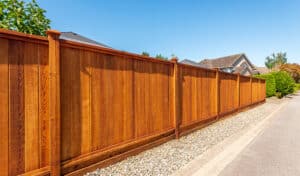
The frequency of pressure washing fence structures should also depend on your location and environment. If you live in a place that exposes your fence to harsher conditions, then you will likely need to pressure wash it more often.
That said, a good rule of thumb is to pressure wash your fence at least once per year.
Pressure Washing vs Power Washing Fence: Which Is Better?
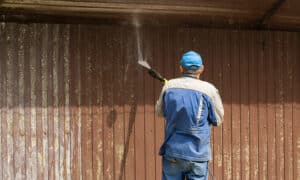
Pressure washing is a good base option for fence cleaning. It’s well-suited for fences that aren’t too filthy. If you have a fence with years’ worth of dirt and grime, you are better off using a power washer. The same goes if you have a moldy fence or a fence with oil stains.
Frequently Asked Questions
Can you pressure wash vinyl fences?
Yes, you can pressure wash vinyl fences. The same tips and techniques still apply. You should use the correct pressure setting, nozzle, and cleaner. You should also wash in sections and work from the bottom up.
Can you pressure wash metal fences?
Yes, you can pressure wash most metal fences like those made with wrought iron. The same tips and techniques still apply. However, if you have a steel fence, it’s best to avoid pressure washing. This could chip off the paint and cause surface damage. Instead, consider washing the steel fence by hand.
Meanwhile, aluminum fences require little maintenance. All you need to clean them is to wipe them down with a soft, dry cloth. You can clean areas with stubborn dirt or grime with some warm water. Do not use anything acidic like vinegar because it may corrode the aluminum.
Do I need to pressure wash my fence before painting?
While not essential, it is generally a good idea to pressure wash your fence before staining or re-painting it. Pressure washing helps effectively remove dirt and stubborn stains, allowing you to work on a blank canvas. Stain and paint also tend to adhere better to a clean surface.
Skip the Headache, Hire a Pro for Fence Pressure Washing
There are several things to consider before you pressure wash a fence. You must factor in several things including safety, PSI level, nozzle tips, and technique. To an amateur, this can feel overwhelming. Fortunately, several companies offer expert fence pressure washing services.
Washh is one of them. We offer reliable fence pressure washing services to residential properties. Call us today at 704.321.8000 or contact us online to get a free estimate!
RELATED ARTICLES:
- Pressure Washing Chemicals: Which Are The Safest, Most Effective, Or Most Harmful?
- A Beginner’s Guide On How To Pressure Wash A Driveway
- Residential Pressure Washing: Benefits, Services, And Estimates
